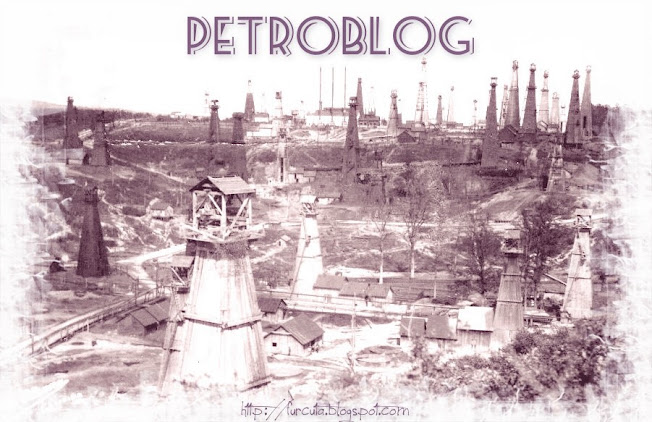Mislisoara-Bustenari wooden derricks
Bustenari-Mislisoara oilfield 1907.
Oil wells at Grausor-Bustenari, Prahova.
Hand dug wells in Bustenari, Romania 1903.
Mislisoara-Bustenari wooden derricks 1907.
Manual drilling rigs at Bustenari 1903.
Doftana and Mislisoara Valley - Bustenari 1907.
Wooden derricks - Bustenari 1906.
Romanian oil industry 1911-1916
'' The Rumanian oil industry enjoyed a period of prosperity from 1911 to 1916 following the development of unusually rich tracts along the Moreni-Baicoi belt of diapiric salt anticlines. The complex structural conditions were now fairly well understood, and the early use of geology by most of the had brought development operations probably to a higher state of general efficiency than prevailed in any other country. Production was from sands in the Dacic series and from Meotic sands about 2,000 feet deeper near the base of the Pliocene.The Dacic is very productive but oil occurrences in it are very erratic and of limited extent. Throughout the proved area of the Dacic series, the average production is 120,000 barrels per acre. At Moreni, the best section of the south flank of the salt anticline averaged 350,000 barrels per acre, but on the opposite side of the salt from this very rich section, no oil whatsoever occurs in this formation. Oil from the Dacic is produced for the most part along the Moreni-Baicoi trend... The Meotic is more regular and is ordinarily found productive where structural and sand conditions are favorable. This series is much less rich than the Dacic--averaging 30,000 barrels per acre throughout its proved area. Gross production amounted to 13,555,000 barrels in 1913 in spite of problems imposed by the Balkan wars. The three major operators were still dominant, but large new wells in 1913 placed Royal Dutch-Shell's Astra Romana and Standard of New Jersey's Romano Americana ahead of the German controlled Steaua Romana. In 1914, Astra produced about 3,400,000 barrels, Americana 3,100,000 barrels, and Steaua 2,700,000 barrels .
Burning petroleum wells at Buzau, during the First World War.
Date : 1916
Rumania entered World War I on the side of the Allies in 1916 and many of the oil installations were destroyed in advance of the invasion of the German armies. Production dropped to 3,721,000 barrels in 1917, but the long familiarity of Steaua Romana's geologists and engineers with the local fields was helpful in enabling the German forces to make effective use of Rumanian oil during the period of their occupation.The number of petroleum geologists in Rumania between 1911 and 1916 is known to have been substantial, but most of their identities and affiliations are obscure. Steaua Romana probably still had the largest technical departments. Astra Romana had acquired the staff of Regatul Roman by merger, and its local organization shared also in the personnel and services of the Central Geological Bureau which Royal Dutch-Shell had established under Erb at The Hague. Several of the important smaller companies had become addicted to the use of geology in earlier years, and several consultants worked in the oil country at various times. The only full-time geologist for Romano Americana before the German occupation was Silas C. Stathers, who had started as a civil engineer for Jersey Standard many y ars earlier and worked here in 1914-1916 before returning to the United States as the first chief geologist of Standard Oil Company of Louisiana. During the summer field season for more than 20 years, Romano Americana employed Ion Popescu-Voitesti, a former student of Mrazec, professor of geology at the universities of Cluj and Bucharest successively, and later director of the Rumanian Geological Survey Restoration of the oil business after the war was hampered for a time by the inflation and political readjustments which were prevalent in Europe, while the character of the industry underwent major changes. Steaua Romana, as a former enemy property, passed front German to local control. Astra Romana resumed large-scale activities, although Royal Dutch-Shell was putting more emphasis on its vast undeveloped holdings in the western hemisphere. Standard of New Jersey, which was pinched for oil supplies everywhere, established a geological department in Romano Americana with E. T. Hancock as chief and 3 to 5 assistants. Their first efforts were devoted to reconditioning old wells and drilling deeper ones on the leases at Moreni and Baicoi, but they could not bring production back to the 914 level (Gibb and Knowlton, 1956). Rumania as a whole was unable to surpass its 1913 production until 1925, but enjoyed unprecedented success during the next 10 years ''.
Burning oil storage tanks at Campina
''Campina near Ploesti, Rumania. 16 May 1944. Aerial view from a South African Air Force Mosquito aircraft shows the burning oil storage tanks at Campina, twenty miles northwest of Ploesti, a few hours after RAF Handley-Page Halifax and Vickers-Armstrong Wellington bomber aircraft had bombed the refinery and marshalling yards. Half an hour after this, 15th Army Air Force (USA) Consolidated B-24 Liberator bomber aircraft also attacked Campina railyards, hits being scored on a refinery, rolling stock and tank cars. Productive capacity of Ploesti refining system has been reduced to less than twenty five per cent of its normal output as a result of day and night attacks by Strategic Air Force.''
Subscribe to:
Comments (Atom)


























%2C%2BRomania%2C.png)


























